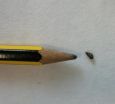(Press-News.org) Animals that literally have holes in their brains can go on to behave as normal adults if they've had the benefit of a little cognitive training in adolescence. That's according to new work in the August 23 Neuron, a Cell Press publication, featuring an animal model of schizophrenia, where rats with particular neonatal brain injuries develop schizophrenia-like symptoms.
"The brain can be loaded with all sorts of problems," said André Fenton of New York University. "What this work shows is that experience can overcome those disabilities."
Fenton's team made the discovery completely by accident. His team was interested in what Fenton considers a core problem in schizophrenia: the inability to sift through confusing or conflicting information and focus on what's relevant.
"As you walk through the world, you might be focused on a phone conversation, but there are also kids in the park and cars and other distractions," he explained. "These information streams are all competing for our brain to process them. That's a really challenging situation for someone with schizophrenia."
Fenton and his colleagues developed a laboratory test of cognitive control needed for that kind of focus. In the test, rats had to learn to avoid a foot shock while they were presented with conflicting information. Normal rats can manage that task quickly. Rats with brain lesions can also manage this task, but only up until they become young adults—the equivalent of an 18- or 20-year-old person—when signs of schizophrenia typically set in.
While that was good to see, Fenton says, it wasn't really all that surprising. But then some unexpected circumstances in the lab led them to test animals with adolescent experience in the cognitive control test again, once they had grown into adults.
These rats should have shown cognitive control deficits, similar to those that had not received prior cognitive training, or so the researchers thought. Instead, they were just fine. Their schizophrenic symptoms had somehow been averted.
Fenton believes their early training for focus forged some critical neural connections, allowing the animals to compensate for the injury still present in their brains in adulthood. Not only were the animals' behaviors normalized with training, but the patterns of activity in their brains were also.
The finding is consistent with the notion that mental disorders are the consequence of problems in brain development that might have gotten started years before. They raise the optimistic hope that the right kinds of experiences at the right time could change the future by enabling people to better manage their diseases and better function in society. Adolescence, when the brain undergoes significant change and maturation, might be a prime time for such training.
"You may have a damaged brain, but the consequences of that damage might be overcome without changing the damage itself," Fenton says. "You could target schizophrenia, but other disorders aren't very different," take autism or depression, for example.
And really, in this world of infinite distraction, couldn't we all use a little more cognitive control?
###
Lee et al.: "Early cognitive experience prevents adult deficits in a neurodevelopmental schizophrenia model.
END
LONDON, ON – The impact of bipolar disorder during pregnancy has been hotly contended among the research community. Now, a new study from Lawson Health Research Institute and Western University is sorting out the debate and calling for more targeted, prospective research.
Bipolar disorder is characterized by depression, hypomania, or mania. It is most common among women, and its episodes are often concentrated during the height of the reproductive years.
Bipolar disorder can lead to suicide, infanticide, and increased risk for psychiatric hospitalization during the ...
Medicines for Malaria Venture has developed a framework to evaluate the risk of resistance for the antimalarial compounds in its portfolio. A paper based on this work: A framework for assessing the risk of resistance for antimalarials in development has been published in the Malaria Journal today.
Resistance defines the longevity of every anti-infective drug, so it is important when developing new medicines for malaria, to check how easily promising antimalarial compounds will select for resistance. Once this is known, it facilitates the prioritization of not only the ...
Human and chimp brains look anatomically similar because both evolved from the same ancestor millions of years ago. But where does the chimp brain end and the human brain begin?
A new UCLA study pinpoints uniquely human patterns of gene activity in the brain that could shed light on how we evolved differently than our closest relative. Published Aug. 22 in the advance online edition of Neuron, these genes' identification could improve understanding of human brain diseases like autism and schizophrenia, as well as learning disorders and addictions.
"Scientists usually ...
UCSF researchers found that poor HIV-infected individuals living in San Francisco are significantly more likely to visit emergency rooms and to have hospital stays if they lack access to food of sufficient quality and quantity for a healthy life.
"In the prior three months, a quarter of participants in the study reported an ER visit, and just over a tenth reported a hospitalization, which shows that we are dealing with a population with high levels of illness. But the food insecure people were even sicker than the food secure, which is consistent with their experiencing ...
A compound found in green tea could be a weapon in treatments for tackling cancer, according to newly-published research at the University of Strathclyde in Glasgow, Scotland.
The extract, known as epigallocatechin gallate, has been known to have preventative anti-cancer properties but fails to reach tumours when delivered by conventional intravenous administration.
However, in initial laboratory tests at the Universities of Strathclyde and Glasgow, researchers used an approach which allowed the treatment to be delivered specifically to the tumours after intravenous ...
ILW makes up more than three quarters of the volume of material destined for geological disposal in the UK. (1)
Currently the UK's preferred method is to encapsulate ILW in specially formulated cement. The waste is mixed with cement and sealed in steel drums, in preparation for disposal deep underground.
Two studies, published in the latest issues of The Journal of Nuclear Materials and European Journal of Glass Science and Technology A show that turning this kind of waste into glass, a process called vitrification, could be a better method for its long-term storage, ...
Invasive species – plants, animals, and microbes introduced to regions beyond their native range – carry a global price tag of $1.4 trillion dollars. They are responsible for the loss of natural resources and biodiversity, damages to infrastructure, and an uptick in infectious diseases.
Not all non-native species pose a threat. Scientists around the world have spent the last several decades teasing apart the conditions that set the stage for debilitating invaders, like giant hogweed, zebra mussels, or gray squirrels. A number of hypotheses have emerged to help predict ...
Nowadays, an increasing number of rivers and lakes are being invaded by exotic snails, which come from remote regions, and even other continents. Such species represent a threat to native species, as they compete for food or space with them.
This is the case of the mudsnail Potamopyrgus antipodarum. This small aquatic snail is native to New Zealand, and has spread throughout rivers, lakes or streams in Europe, Australia, America and Asia. The invasion success of this mudsnail may be partly due to the ability of females to reproduce without participation of males (i.e. ...
Health risks posed to people who work with tiny fibres used in manufacturing industries could be reduced, thanks to new research.
Research into the health risks posed by nanofibres – used to strengthen objects from tennis rackets to airplane wings – has pinpointed the lengths at which these fibres are harmful to the lungs.
Nanofibres, which can be made from a range of materials including carbon, are about 1,000 times smaller than the width of a human hair and can reach the lung cavity when inhaled.
This may lead to a cancer known as mesothelioma, which is known to ...
Australian scientists studying the impact obesity has on pregnancy, are urging men to get 'match fit' before conceiving to assist with fetal development.
Reproductive experts from the University of Melbourne's Department of Zoology have discovered that a father's obesity negatively impacts sperm, resulting in smaller fetuses, poor pregnancy success and reduced placental development.
While the health risks surrounding obesity and pregnancy have largely been centred on overweight mothers, scientists from the University of Melbourne are putting the onus on men to shape ...



